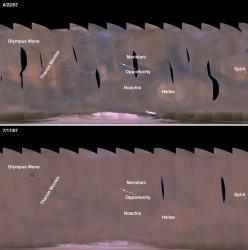Okay, this is starting to get worrysome. As I reported twice in the past few weeks, there’s a series of dust storms currently raging across the surface of Mars. And the plucky Mars rovers, Spirit and Opportunity are right in the middle of it. NASA put out a news release today, that was a little grim.
They’re worried about Opportunity.
As you know, the Mars Exploration Rovers are solar powered. Every activity they take: driving around, using their instruments, and communicating with Earth requires electricity generated through solar power. The power isn’t an option, it’s a necessity. That’s because they use the energy to run a heater that keeps their most fragile equipment warmed during the frigid Martian nights.
The latest communications received from Opportunity on July 30, 2007 told a grim tale. Dust from the atmosphere is settling out onto the rovers’ solar panels, blocking the amount of light they receive. The rover is already in a low-power regimen, using the absolutely bare minimum to survive. And the light it’s receiving is steadily going down.
Even though the weather has gotten a little warmer since the dust storm started, the temperature of Opportunity’s electronic modules has gone down at night. Right now, it’s getting down to -37 degrees C (-35 degrees F). This is just within a couple of degrees from the point that the rover will need to turn on its electronics heaters. At that point, the heaters will deplete the rover’s batteries more quickly than it can refill them with sunlight.
NASA engineers have a plan, but it’s a little bit risky. They’re having the rover use its electronics for a longer period each day. If the skies don’t clear up, it might go overboard and switch into a low-power fault mode. This would take the batteries off-line, and put the rover to sleep to wait for sunlight to return. The rover might go to sleep for days, weeks or even months, waiting for enough sunlight to get moving again.
“We will continue to watch the situation on Mars and do all we can to assist our rovers in this ongoing battle against the environmental elements on the Red Planet,” said John Callas, rover project manager at NASA’s Jet Propulsion Laboratory, Pasadena, Calif.
Original Source: NASA/JPL News Release

